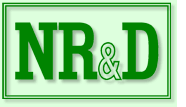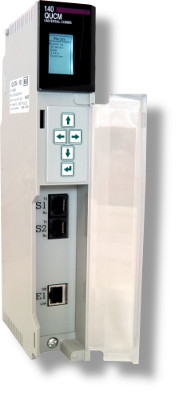
Home
Products
Cables
CAPP Products
DIN Rail Products
Modicon Products
M580
Quantum
QASI
QRIO
QUCM
Cutsheet
Manual
Software
Applications
QSPXM
QXBP
FAQs
Compact
Momentum
Square D Products
Download Area
Price List
Application Notes
Support
NR&D Distributors
User Programmable Application




Description Niobrara's Quantum Universal Communications Modules (QUCM+002, QUCM+102 & QUCM+204) are programmable serial communication modules for Schneider Automation's Quantum® PLC with two or more serial ports, a PLC interface, a LCD display with keypad, a real-time clock, a TCP/IP stack, and internal registers. The QUCM+102 and QUCM+204 offers Ethernet port(s).
The QUCM comes from the factory with the Routing and Protocol Conversion (RPC) application which supports all of the important Schneider North American serial protocols:
Modbus RTU or ASCII, master or slave; SY/MAX Point-to-Point or Net-to-Net; Plogic, PNIM and RNIM (master or slave); Dual Modbus & RNIM master (drop Modbus devices on RNIM
radio networks); Dual Modbus & SY/MAX slave.
Usues for the QUCM Data Concentrator
- Read data from external devices and/or the PLC.
- Allow external devices and/or the PLC to write data to the QUCM.
- Both the PLC and external devices can read the gathered data.
- Time-stamp data for later retrieval.
- Allow devices with different protocols on separate ports to communicate.
- The PLC can use standard MSTRs to read/write non-Modbus devices.
- Non-Modbus devices and read/write the QUCM or the PLC.
- Read/write Modbus Slaves devices from the PLC or the User Application.
- Use MSTRs to read 0x, 1x, 3x, 4x values.
- Use MSTRs to write 0x coils and 4x holding registers.
- Read, write and program the PLC.
- Read and write the QUCM.
- Send and receive e-mails for alarm conditions.
- Access device data and configure setup parameters with a web page.
- Allow Ethernet clients to access PLC and serial slaves.
- Allow serial master to access PLC and Ethernet servers.
Applications The engineers at Niobrara have written several applications
- Interfacing an ACCU-SORT Scanner to a Quantum PLC.
- Interfacing Modbus RTU master to 3694(R) devices.
- Interfacing Modbus RTU master to an Allen Bradley® DF1 device.
- Interfacing Modbus RTU master to ENRON/Daniel Modbus Slaves.
- Gathering data from Simpson Hawk® meters for the Quantum PLC.
The source code for these applications is available here. The applications can be used as is or modified to solve your PLC communication
problem or used as examples to start your own QUCM application development.
QUCM Language The QUCM is programmed via Niobrara's QUCM language. The language has a BASIC-like structure which makes it easy to read and follow. Powerful language extensions for data communications and PLC interfacing make it ideal for use as a PLC communication language. A TCP/IP stack is built in, making it easy to write application layer protocols using TCP, UDP, PPP, and IP. The language is compiled for the fastest possible execution. The compiler is included at no extra charge.
Although the QUCM is designed for user programming, many companies choose to have Niobrara write their QUCM code. Contact Niobrara for a quote.
Application Areas The QUCM can run a single applications with up to 64 parallel threads. All threads have access to the PLC backplane, the serial ports, the LCD display, the real-time clock, the TCP/IP stack, and the internal registers.
Serial Ports The serial ports 1 and 2 on all QUCMs are software selectable RS-232 or RS-485. The QUCM+204 ports 3 and 4 are fixed RS-232. They use Modicon's pinouts, so standard cables work well. They are independently configurable as to baud rate, parity, data bits, and stop bits. Write the protocol of your equipment to:
- Be a Master or a Slave device while multidropping up to 32 devices off of any port
- Build a Protocol Converter
- Build a Data Concentrator for serial or Ethernet devices
- Use the PLC to trigger messages to printers or signs
- Bring data into the PLC from barcode readers, scales, and other ASCII devices
- Build a gateway to allow ASCII devices onto the Ethernet network
- Dial-out to your ISP and communicate on the Internet using PPP
Several serial protocols have been implemented in various products and are available online:
- 3964R
- Caterpillar EMCP Genset
- Caterpillar 3500 Engines
- DNP 3.0
- Dupline I/O
- Allen-Bradley DF1
- Elliott Flow Computer
- ENRON/Daniel Modbus
- Cutler-Hammer INCOM
- GE Multilin 169 Plus
- Johnson Controls N2 (Metasys®)
- Mitsubishi UPS
- Siemens SEAbus & SEAbus+
- Simpson Hawk meters
Ethernet Port (QUCM+102 and QUCM+204 only) The 100BaseT RJ45 Ethernet port defaults to Modbus/TCP protocol. The QUCM has a TCP/IP stack which the user's application can access for easy implementation of various application layer protocols. Several application layer protocols have been implemented; examples are available online.
- HTML/HTTP
- Cutler-Hammer INCOM
- Chat
- FTP
- DNS
- SNMP (Client or server)
- SMTP
- Telnet
- POP3
- Web Server
Backplane The programmer has a choice of backplane interfaces. The QUCM can be either an I/O Module or an Option Adapter.
When the QUCM is configured as an option-module:
- The backplane acts as a bidirectional Modbus port giving both the Quantum processor and the QUCM access to the other's register space.
- The PLC can be programmed from the QUCM.
- Using standard MSTRs, the PLC can speak new Serial Protocols.
- Requires a free slot in the main rack
As an I/O module, the QUCM can be used:
- In any slot in any Quantum rack; local, distributed or remote.
- In applications that require fewer than 32 registers in and 32 registers out.
LCD / Real-Time Clock The QUCM has a high resolution LCD display under Application control. It also has a 5 button keypad that may be read by the application.
A real-time clock is available to the applications and is especially useful for scheduling events or time-stamping data.
Miscellaneous In applications not requiring a PLC, the QUCM can be used stand-alone with Niobrara's QXBP-001. To connect PC COM: port to the QUCM use an MM1 cable. To break-out the RJ-45 connector to screw terminals use a BB85. For optically isolated RS-485 use the DDC2I.
Ordering Information
The QUCM is available as:
* QUCM+002 with two selectable RS-232/RS-485 ports.
* QUCM+102 with two selectable RS-232/RS-485 ports, one 100BaseT Ethernet port
* QUCM+204 with two selectable RS-232/RS-485 ports, two RS-232 ports, two 100BaseT Ethernet ports
Related Equipment
The QUCM has the following equipment available:
* MM1 PC to QUCM configuration cable
* BB85 DIN-rail mount breakout box, RJ45 to screw-terminal connector w/ MM0 cable
* QXBP-001 Single-slot rack with built-in power supply for stand-alone applications
* DDC2I Optically-isolated RS-232 to RS-485 converter, DIN-rail mount w/ MM0 cable
Specifications
Warranty / Manual: The QUCM is furnished with a user manual on cd and carries a one year warranty from the date of shipment. During the warranty period, free firmware upgrades are available. See Niobrara's Standard Terms and Conditions of Sale for additional warranty information.
Dimensions: Standard Quantum register module. 1.59" wide by 9.84" tall by 4.09" deep (40 x 250 x104mm). Approximately 12 oz. (340 g.) net. All connectors and indicators are front mounted except the Quantum bus card edge connector on the back.
Power Requirements: From Quantum bus; 5 VDC, 550 mA max (350 mA typical).
Operating Conditions: 0 to 60 degrees C; humidity up to 90% noncondensing; pressure altitude -200 to +10,000 feet MSL.
Serial Ports: Selectable RS-232/RS-485 ports data I/O ports. 50 - 38400 baud. 7 or 8 data bits; odd, even or no parity; 1 or 2 stop bits. RJ-45 female connectors, Modicon Micro pinout.
Ethernet Ports (QUCM+102 and QUCM+204): 100BaseT, RJ-45 connector
Mailbox Registers: 2,048 4x register and 32 3x registers. Non-volatile. PLC can map up to 32 input and 32 output registers in local or remote I/O racks and up to 30 in, 32 out in distributed I/O racks.
Memory: 5MB FLASH area for Application program and data storage; 8M of volatile RAM memory for variables;
Indicators: LED indicators for Module Active, Ready, Run, Fault, RN1 (application running), RN2 (auto-transfer running); Ethernet Transmit, Receive, Link, Collision; Serial Port Transmit (2), Receive (2). 24 total indicators. 10 user controlled LEDs.
* Schneider Automation holds a patent for serving web pages from a PLC. If the QUCM is used to serve web pages from the Quantum PLC a license is required. This license is available from NR&D at additional cost or from Schneider Automation.
